MAA archaeologists surveyed 116 acres during 1999 and 2000 to identify potential archaeological and historic sites in the area associated with its proposed car rental facility and parking areas. During this initial survey, MAA’s archaeologists identified two artifact concentrations in the central portion of the project area that included:
- Household materials, such as ceramics, container glass, metal can fragments, and coal; and
- Architectural materials, such as bricks, nails, and window glass fragments.
The artifacts suggested that the area once included a house or farmstead. The date-able nails and household materials that MAA found indicated that the site was occupied from the early 18th century to the early 20th century. MAA found that the site contained relatively intact soils with the potential to contain additional cultural material.
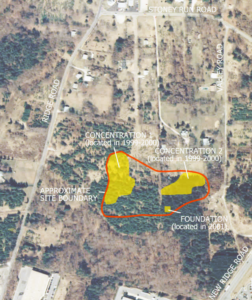
MAA researched maps, deeds, manuscripts, and local histories and consulted with the Maryland Historical Trust (MHT) to learn more about the site, its occupants, and their lives. The research indicated that the site had once been part of Plummer’s Pasture during the late 18th century. Yate Plummer purchased the property in 1762. Daniel Plummer, one of Yate’s sons, lived on the project parcel following his father’s death in 1764 until 1814.

Following the death of Daniel Plummer in 1814, the parcel was purchased by John and Martha Harmon. Land records and census data do not show that the Harmons ever lived on the project parcel during the next four decades, though tenants might have occupied and farmed the parcel. The Harmons sold the project parcel to Basil Smith in 1848, though Basil Smith may never have actually lived there either. By 1860, however, F. Marion Smith, Basil’s son, was living on and farming the project parcel. The 1870 and 1880 agricultural census data indicate F. Marion was a successful and prosperous farmer who participated in the region-wide shift from grain and tobacco agriculture to the garden crops that were the hallmark of the truck farming industry. The parcel remained in the Smith family and was farmed until 1936, when it was sold and subdivided into residential lots.
MAA’s research indicated that the site could be eligible for inclusion in the National Register of Historic Places, because it had the potential to provide information on the agricultural economy of northwestern Anne Arundel County during the 18th, 19th and 20th centuries. Although MAA hoped to avoid and minimize impacts to these important resources, it was unable to do so because the site was in the middle of MAA’s proposed rental car facility. The figure on the left shows the location of the rental car facility relative to the Basil Smith Site.
After consultation with MHT, MAA archeologists decided to conduct a full excavation of the site to recover information that would increase knowledge of the agricultural history in this part of Maryland, as very few 19th century rural farmsteads have been excavated in the region.
Working with MHT, MAA devised a research plan to answer the following questions:
How did farming practices at the site change during the regional shift from tobacco production in the 18th century, to grain production in the early 19th century, before transitioning to truck farming in the late 19th century?
- How do artifacts from the site reflect the different religious practices of its Quaker, then Methodist, occupants?
- What sorts of crops were grown on the site and what was the diet of site occupants through the different periods of occupation?
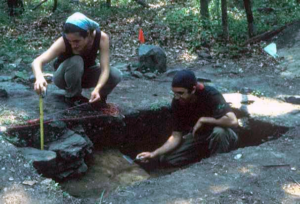
MAA conducted further excavations at the Basil smith Site in 2001, to gather more information about the previously identified artifact concentrations. To their surprise, MAA archaeologists also discovered a small field stone foundation and hearth. The artifacts in and around the field stone foundation were among the richest at the site. Most artifacts were parts of household items, such as ceramic plates and glass canning jars, but personal items such as buttons and a ceramic pipe were also discovered.
Concentration 1
Concentration 1 included an area of domestic artifacts covering almost 2 acres. The concentration covered the top of a small wooded knoll, an adjacent down slope, and a lower flat area believed to represent a filled-in stream basin that was covered with heavy undergrowth. Concentration 1 was the larger and older of the two artifact concentrations and was the first portion of the site identified. Unfortunately, no significant features (such as a building foundation) were discovered. Artifacts such as date-able ceramics and bottle glass indicate that the site was occupied from the late 18th to the mid 19th century.
Architectural Items
The large number of architectural artifacts found in this concentration suggest that a building once stood in the area. Architectural artifacts included very small brick fragments and mortar, window glass, and nails. The brick fragments most likely represent just a few whole bricks. The window glass is all of “modern” manufacturing techniques, suggesting that it dates to the 19th rather than 18th century. Although poorly preserved, most nails are identifiable, primarily newer cut nails, though archaeologists also recovered older hand-wrought nails, and modern wire nails as well. The nails are of all different types (floor, finishing, etc.) and date from the 18th-19th centuries.
The architectural materials provide few clues as to the type or function of the former structure. The small number of nails indicate that the structure was not lumber framed. The structure may have been constructed from logs, but no foundation or sill features were identified. The small number of bricks and brick fragments recovered indicate that the structure was not of brick construction, although it might have had a brick chimney.
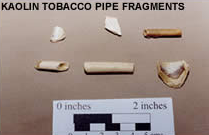
Household Items
Domestic materials found in Concentration 1 include ceramics (such as dinnerware) and bottle glass. The ceramic and glass pieces provided the most clues about the age of a site and the wealth of its occupants.
Ceramics, such as earthenware, cream-ware, and pearl-ware indicate that the site might have been occupied during the late 18th and early 19th centuries. Fragments of a kaolin tobacco pipe and five shreds of dark olive and olive green wine bottle glass also reflect this period. These artifacts were luxury items, indicating that the site occupant at this time was prosperous. Few utilitarian wares (such as bowls or crocks used in food preparation or storage) were recovered. Other ceramic artifacts such as white-ware, ironstone, and yellow-ware shreds, as well as brown, blue, pink, and clear bottle glass fragments indicate that the site might have been occupied from the early 19th to early 20th century.
Many researchers at similar sites found that with the advent of fully automated glass container production, the ratio of container glass to ceramics discovered during excavation is usually high. In Concentration 1, however, the ratio is low. The relative absence of manufactured glass indicates that the site was probably not occupied or used much during the 20th century.
Many researchers at similar sites found that with the advent of fully automated glass container production, the ratio of container glass to ceramics discovered during excavation is usually high. In Concentration 1, however, the ratio is low. The relative absence of manufactured glass indicates that the site was probably not occupied or used much during the 20th century.
Concentration 2
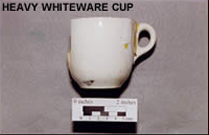
Concentration 2 included a 1-½ acre area located in the northeastern portion of the site, along a wooded ridge and hill slope and a portion of an overgrown lower flat that is believed to represent the previously identified stream bed. Archaeologists hoped to find intact deposits of artifacts, but the area was previously disturbed. The artifacts recovered from this concentration included utilitarian household items and ceramics dating to the later period of occupation (mid 19th century to early 20th century).

Foundation
The foundation at the Basil Smith site, located on a wooded, gently sloped terrace south of the artifact concentrations, was not discovered until one year after archaeologists had discovered Concentrations 1 and 2. Archaeologists uncovered a portion of a 16′ X 18′ field stone foundation south of the artifact concentrations. In addition to the foundation, archaeologists located a large hearth, and a concentration of brick that was probably from the structure’s chimney.

Archaeologists hoped to find information on the relative wealth, cultural affiliation, and ethnicity of the site inhabitants. The area was undisturbed and rich in artifacts. The large number of nails recovered indicate that the structure was made of milled lumber rather than logs. Archaeologists found no evidence that the structure was ever equipped for electricity, gas, or plumbing.

Household Items
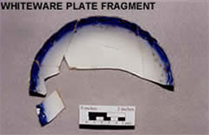
Domestic materials such as ceramics, container glass, a portion of a clothing iron, and a pair of scissors indicate that the structure was probably a residence. Most artifacts were discovered along the perimeter of the foundation, but fragments of glass bottles were clustered immediately adjacent to the structure. The bottles may have been deposited after the structure was abandoned. The artifacts suggest that the structure was occupied sometime during the mid 19th century to the early 20th century.
Ceramics
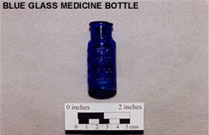
A total of 55 vessels were reconstructed from the ceramic shreds recovered in the foundation deposits, 39 of which are undecorated. Most of the ceramic vessels are single vessels without matches, which indicates that vessels were purchased piecemeal rather than in matching sets.
Container Glass
Archaeologists recovered a large array of bottle glass from the foundation deposits, but only two jars and four tin, glass-liner style canning lids. Most of the collection consists of medicinal, household, food, and toiletry containers. Many of the bottles were linked to manufacturers in Baltimore.
Faunal
The faunal (or bone) materials refer to the remains of animals that were used as food sources. Archeologists found bones from multiple wild and domestic species such as deer and pigs. The type of animal bones (beef, pork, etc.) and the type of cut (roast, chops, etc.) provided clues about the diet and economic status of the site occupants. The large portion of game indicates that the occupants hunted for much of their food, and the pork bones represented lower value cuts of pork, indicating that the residents were not wealthy.

Clothing/Personal Items
Thirty buttons were found near the foundation. Thirteen of these buttons are simple milk glass buttons. The rest of the buttons include seven minimally decorated glass buttons, two shell buttons, a bone button, five metal buttons (likely covered in cloth at one time), a faceted and lustered black glass woman’s coat button, a black glazed ceramic button, and one Bakelite button. Other personal artifacts include a glazed stoneware pipe bowl, clockwork gears from a pocket watch or clock, the leads from at least three pencils, and the teapot lid from a child’s tea set.

Picker’s Checks
Eight picker’s checks, associated with the truck farming industry in Anne Arundel County, were recovered from the foundation. The picker’s checks were either round or octagonal, and all were stamped with the initials “N.Q”. They are believed to be associated with the Noah Queen farm, an African-American owned farm which operated to the north of the project parcel from approximately 1880 until the second quarter of the 20th century.

